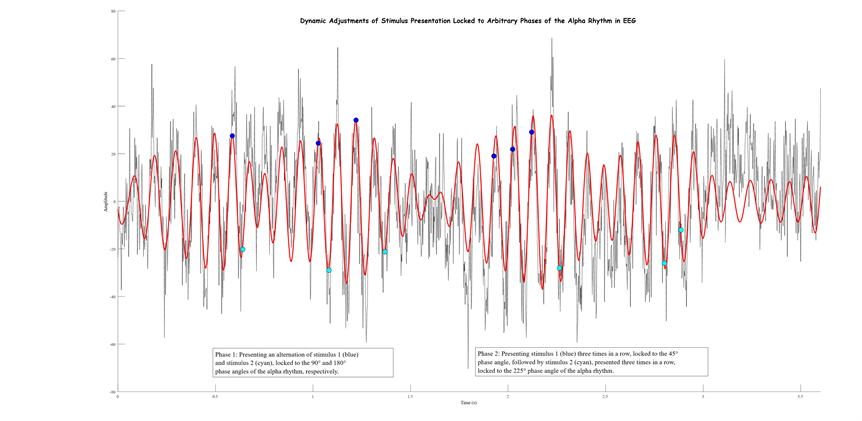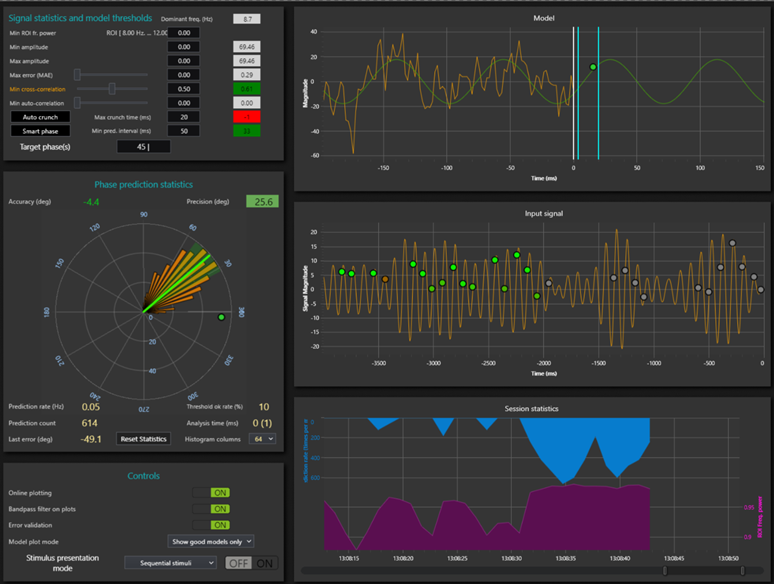Phase-Locked Stimulus Presentation
Phase-locking refers to the technique of synchronising external stimuli—such as TMS pulses, auditory tones, or visual flashes—to specific phases of ongoing brain rhythms. In cognitive neuroscience, this approach enables researchers to probe how precise timing affects neural processing and behaviour.
Using real-time EEG monitoring, Phase-Prediction AddIn for EventIDE software predicts the upcoming phase of neural oscillations (e.g., theta or alpha) and preloads stimuli accordingly. This ensures stimuli are presented when the brain is most responsive, allowing for causal investigation of oscillation-based cognitive functions such as memory encoding, visual awareness, and attention.
By predicting a future appearance of a selected target phase, researchers can go beyond traditional post-hoc analyses and implement true closed-loop interventions in real time.
Key Features
- Precise locking to an arbitrary target phase(s) in a real-time oscillatory brain signal
- Tracks multiple frequency bands & brain regions simultaneously
- Compatible with TMS, visual/auditory systems, and experimental platforms
- Designed for academic and research use
- Enables causal, phase-specific intervention, not just post-hoc analysis
- Seamless synchronization with standard lab equipment through EventIDE software, allowing aligning data from multi-modal sources
- Visual analysis of phase-locking results with PhInsight application
Real-time instrumental panel for phase-locking in EventIDE:
Closed-Loop Brain Stimulation Setup with PsyPhy
We have partnered with PsyPhy to offer a portable, out-of-the-box solution for closed-loop phase-locking studies. This advanced research platform combines a 19-channel EEG system with real-time phase prediction and precise stimulus control by our software, EventIDE.
Key Benefits
- This platform enables researchers to deliver interventions precisely aligned with brain oscillations with millisecond precision — pushing the boundaries of what’s possible in memory research, visual perception, and clinical applications
- Allows dynamic, script-controlled adjustments of target phase(s) at runtime
- Designed for ease of use, the system runs both EEG acquisition and closed-loop processing on a single laptop and integrates seamlessly with external hardware like TMS
Setup Overview
- 19-channel research-grade EEG amplifier (104–20 system)
- 1000 Hz sampling rate, 24-bit resolution
- Minimal latency, real-time data streaming
- Signal recording and stimulus presentation run from the same laptop
- Seamless TMS integration: pulses triggered directly from stimulus setup
- Accuracy: Approximately 1° mean error for the occipital alpha rhythm
- Algorithm's computing time can reach as low as 1 ms
Learn more details on the Brain Stimulation Setup on the PsyPhy website
Demo Videos
This video demonstrates how to configure and run a phase-locked stimulus presentation in just a few minutes
The next video demonstrates using special tools for offline phase-locking simulations and detailed result analysis:
Applications
Memory Research
Building on foundational studies (e.g., Clouter et al., 2017; Zrenner et al., 2018), our system enables phase-locked presentation of multisensory stimuli and TMS delivery to investigate the causal role of theta-phase synchrony in memory encoding and retrieval.
Advanced Capabilities:
- Preload complex audio-visual stimuli with exact theta phase alignment
- Real-time adjustments to match dynamic brain rhythms
- Target specific phase offsets between regions or stimuli
- Integrate TMS pulses during encoding or recall based on predicted phase
Use case:
Investigating memory enhancement via theta phase synchrony across brain regions.
Visual Perception
Using alpha-band (8–12 Hz) phase prediction, researchers can now present visual stimuli at specific phases to explore perception as a rhythmic, state-dependent process (Mathewson et al., 2009).
Advanced Capabilities:
- Present threshold-level stimuli at precise alpha phases
- Generate psychometric functions modulated by phase
- Conduct cross-modal (audio-visual) timing experiments
- Deliver TMS to visual cortex based on predicted excitability states
Use case:
Studying visibility windows and attention modulation using real-time alpha tracking.
Clinical Research
Phase-dependent stimulation has growing relevance for depression, epilepsy, ADHD, and sleep disorders.
Applications:
- Depression: Align frontal TMS pulses with alpha peaks for greater efficacy
- Epilepsy: Track and interrupt phase patterns linked to seizure onset
- ADHD / Attention: Enhance cognitive training during optimal attention windows
- Sleep: Deliver sound cues during slow-wave sleep to boost consolidation
Use case
Move from fixed-interval to state-adaptive stimulation protocols tailored to brain state.



